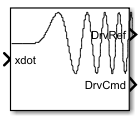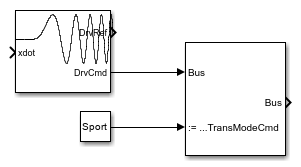Swept Sine
Libraries:
Vehicle Dynamics Blockset /
Vehicle Scenarios /
Drive Cycle and Maneuvers
Description
The Swept Sine block generates steering, accelerator, and brake commands to conduct a swept sine maneuver. Once the vehicle reaches the target longitudinal velocity, the block initiates a swept sinusoidal steering command using the prescribed amplitude, final frequency, and duration.
You can use the swept sine maneuver to characterize the transient vehicle response as done in ISO 7401:2011.
Note
For information on the reference generator block used in the swept sine reference application, see Swept Sine Reference Generator.
Ports
Input
Output
Parameters
Extended Capabilities
Version History
Introduced in R2024b

